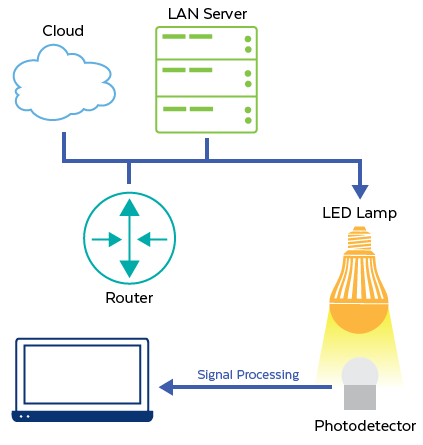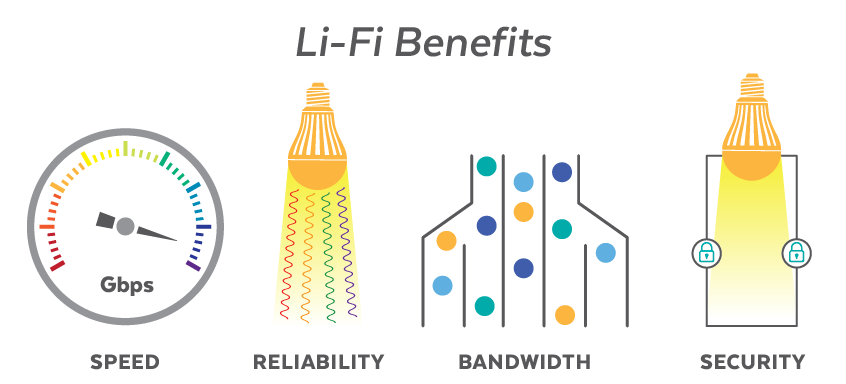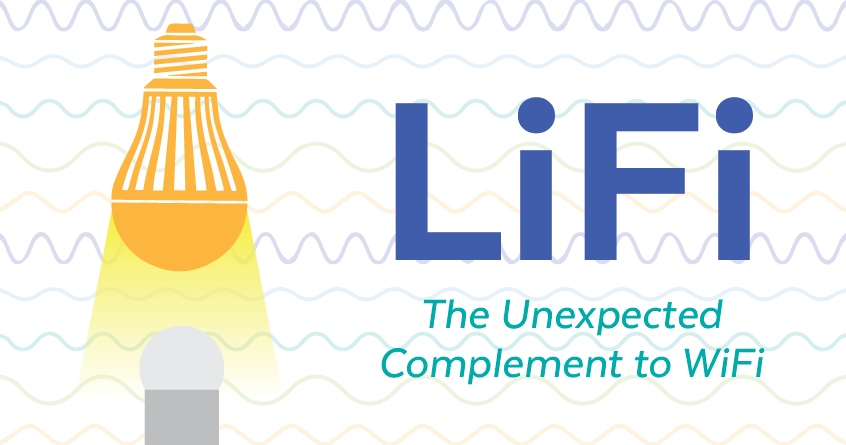In the ever-evolving landscape of wireless communication, LiFi, or 802.11bb, has emerged as a game-changer, promising impressive wireless speeds and a unique complement to traditional Wi-Fi. As businesses, public buildings, transportation hubs, and academic institutions explore the potential of this technology, Power over Ethernet (PoE) technology can be a crucial supporting player in this narrative.
What Is LiFi (802.11bb)?
LiFi, an abbreviation for Light Fidelity, is a groundbreaking wireless communication technology represented by the IEEE standard 802.11bb. Unlike traditional wireless communication technologies such as Wi-Fi, which rely on radio frequencies, LiFi harnesses visible light to transmit data. This innovative approach opens new possibilities for faster, more secure, and more reliable wireless communication.
How Does It Work?
LiFi operates on the principle of Visible Light Communication (VLC). It utilizes light-emitting diodes (LEDs) to rapidly modulate light signals, a process invisible to the human eye. These modulated light signals carry data, turning the light source into a high-speed communication medium. Receivers with photodetectors capture and interpret these signals, enabling data transfer between devices. By flickering the light at a rate beyond human perception, it enables data transmission like traditional wireless communication methods but with light waves instead of radio waves.
 How Does It Compare to Wi-Fi?
How Does It Compare to Wi-Fi?
LiFi and Wi-Fi, although serving the same fundamental purpose of wireless communication, differ in their underlying technologies. LiFi’s use of light waves instead of radio waves results in several key distinctions:
- Speed: LiFi has the potential to achieve significantly higher data transfer speeds than Wi-Fi. Theoretically, it can reach speeds in the gigabits per second range, surpassing the capabilities of traditional Wi-Fi.
- Reliability: LiFi communicates using light waves instead of radio frequencies, eliminating the possibility of electromagnetic interference from electronic devices. This feature makes it suitable for environments with specific communication requirements.
- Bandwidth: The visible light spectrum used by Li-Fi provides a vast and unexplored bandwidth compared to WiFi’s crowded radio frequency spectrum. This expansion into new spectrums could alleviate the issue of network congestion and improve overall network performance.
- Security: LiFi’s inherent characteristics, such as limiting signals to the line of sight and using light waves, enhance security features. The reduced risk of signal interception and eavesdropping makes it a compelling choice for use cases where data privacy is paramount.
 It is important to note that LiFi, or 802.11bb, isn’t intended to replace Wi-Fi but rather to complement it. This distinction arises from the unique strengths of LiFi, such as its higher reliability, lower latency, and reduced vulnerability to interference. Its development is fueled by the need for alternative communication solutions that cater to scenarios where traditional wireless technologies face challenges. It is designed to excel in environments like classrooms, medical facilities, and industrial settings, where higher reliability, lower latency, and enhanced security are paramount. The coexistence of Wi-Fi and LiFi creates a dynamic and versatile communication ecosystem catering to a diverse array of needs across various sectors.
It is important to note that LiFi, or 802.11bb, isn’t intended to replace Wi-Fi but rather to complement it. This distinction arises from the unique strengths of LiFi, such as its higher reliability, lower latency, and reduced vulnerability to interference. Its development is fueled by the need for alternative communication solutions that cater to scenarios where traditional wireless technologies face challenges. It is designed to excel in environments like classrooms, medical facilities, and industrial settings, where higher reliability, lower latency, and enhanced security are paramount. The coexistence of Wi-Fi and LiFi creates a dynamic and versatile communication ecosystem catering to a diverse array of needs across various sectors.
Challenges and Limitations
While LiFi presents exciting possibilities, it is essential to acknowledge the challenges and limitations associated with its implementation:
- Limited Range: LiFi signals are confined to the visible light spectrum, so the technology may not be suitable for long-range communication or outdoor applications.
- Line-of-Sight Requirement: LiFi requires a direct line of sight between the transmitter and receiver, making it less practical for scenarios where obstacles might obstruct the light path.
- Susceptibility to Light Conditions: LiFi performance can be affected by ambient light conditions. Natural light variations and other light sources in the environment could interfere with signal quality.
It Isn’t the First Light-Based Technology
While this technology is capturing attention as a revolutionary light-based communication technology, it is not the first of its kind. Fiber optics, a well-established technology, has been using light to transmit data for years. Fiber optic cables leverage the properties of light to carry information over long distances with minimal signal loss, forming the backbone of many modern communication networks.
LiFi’s Maximum Speeds
The speed of light, a fundamental constant in physics, plays a crucial role in LiFi’s capabilities. Light travels incredibly fast, and LiFi leverages this property for rapid data transmission.
While actual speeds can vary based on specific implementations and environmental factors, theoretical estimates suggest that LiFi can reach gigabits per second (Gbps) range speeds.
These high-speed capabilities make it a compelling choice for applications where rapid and reliable data transfer is essential. LiFi’s maximum speeds can outpace traditional WiFi, offering a more efficient and responsive communication experience in high-density data environments.
The IEEE Standard for LiFi
The IEEE established standard 802.11bb to provide a framework for developing and implementing LiFi technology. This global standardization effort is crucial for ensuring compatibility, interoperability, and a consistent approach to implementing LiFi solutions across industries. The standardization fosters accelerated adoption, opening doors to a future where LiFi seamlessly integrates with existing communication technologies.
LiFi and Power over Ethernet (PoE)
Power over Ethernet (PoE) is a technology that simplifies the deployment and management of networked devices by delivering electrical power alongside data over a single Ethernet cable. This innovation has become integral to networking, providing a streamlined power and data delivery solution.
 LiFi’s functionality is inherently tied to light, and deploying PoE technology can help support its seamless integration. PoE simplifies the installation and remote access of LiFi systems, making it an ideal companion for businesses and institutions seeking efficient and effective communication solutions.
LiFi’s functionality is inherently tied to light, and deploying PoE technology can help support its seamless integration. PoE simplifies the installation and remote access of LiFi systems, making it an ideal companion for businesses and institutions seeking efficient and effective communication solutions.
Why LiFi Could Have a Bright Future
The future of wireless communication will be illuminated by LiFi, and Fraunhofer HHI, a key developer of LiFi standards, envisions a broad spectrum of applications where LiFi could shine. Fraunhofer HHI says LiFi holds immense promise in “classrooms, medical, and industrial scenarios.” These environments, each with diverse communication needs, could benefit significantly from the unique strengths of this technology.
One standout feature is LiFi’s ability to reduce the risks of jamming and eavesdropping. Unlike traditional radio frequency-based technologies, its reliance on light waves limits its signals to the line of sight, enhancing the security of data transmission.
LiFi doesn’t stop at revolutionizing communication; it extends its capabilities to enable “centimeter-precision indoor navigation.” This precision navigation opens up possibilities for applications in various sectors, including smart buildings, logistics, and manufacturing, where accurate location tracking is essential.
The future of LiFi looks promising, not just for its incredible speed but also for its adaptability to specific environments and its potential to redefine how we communicate and navigate in the world.

